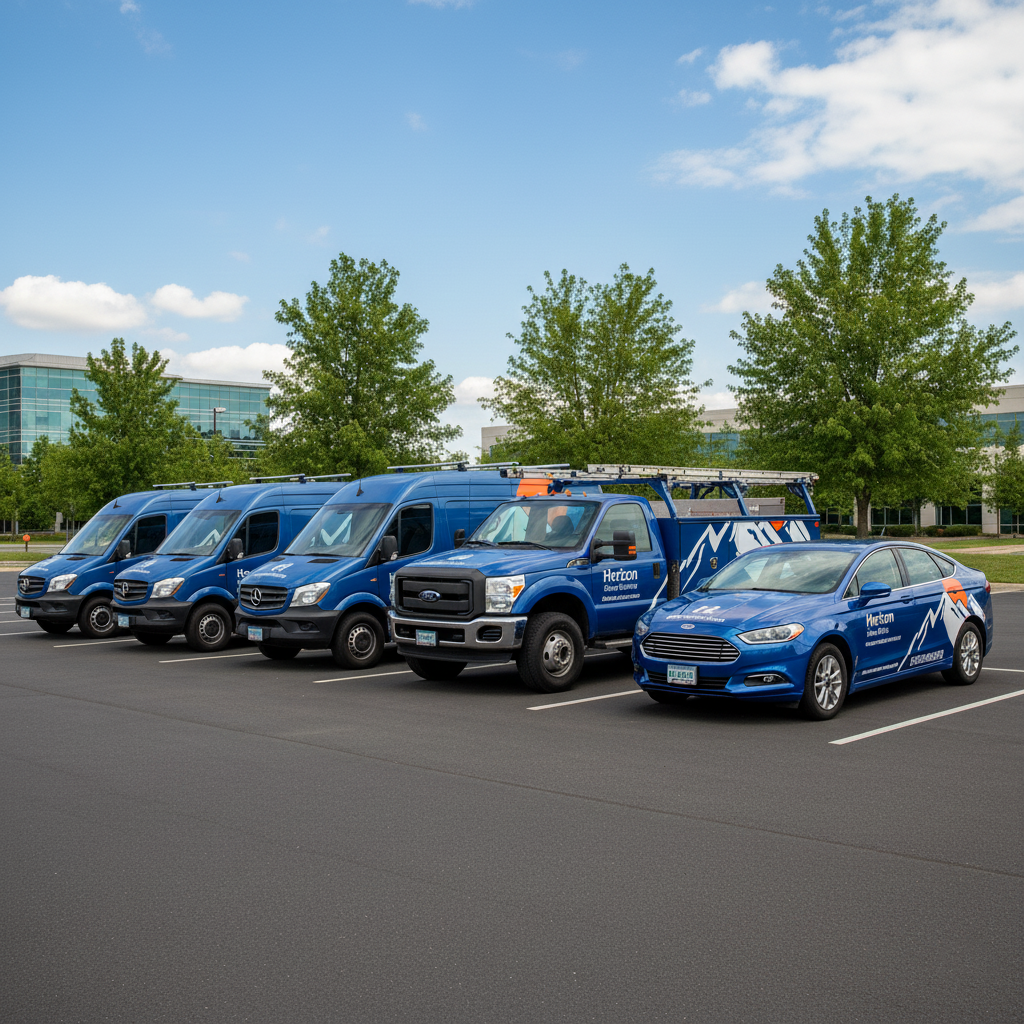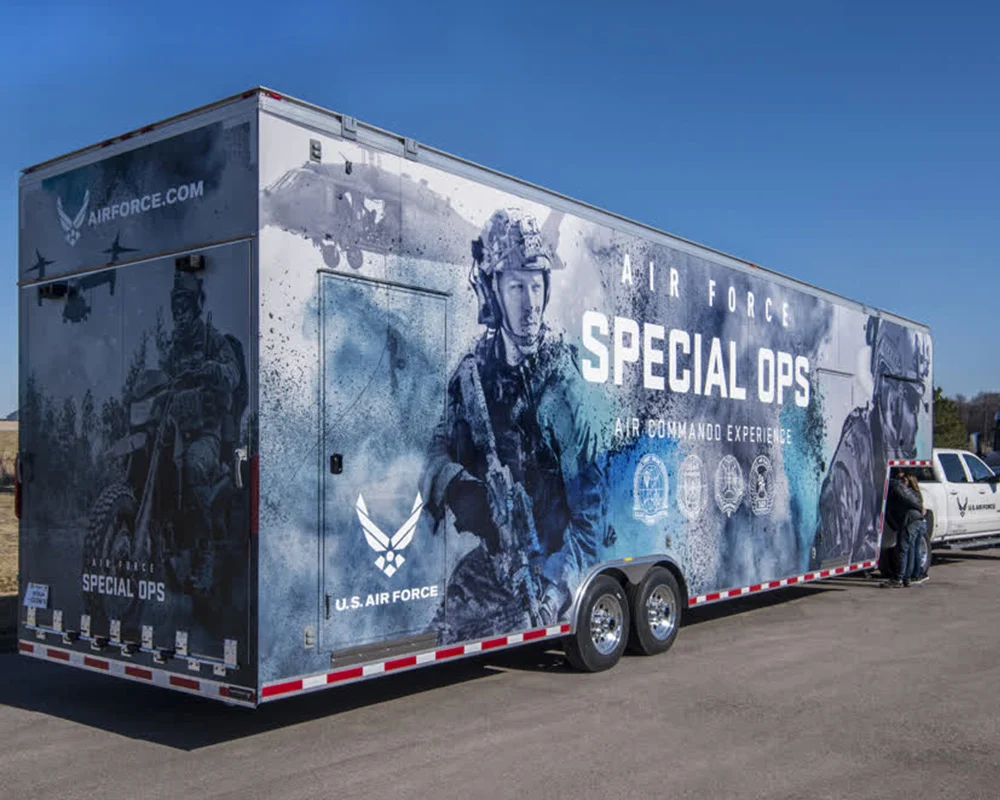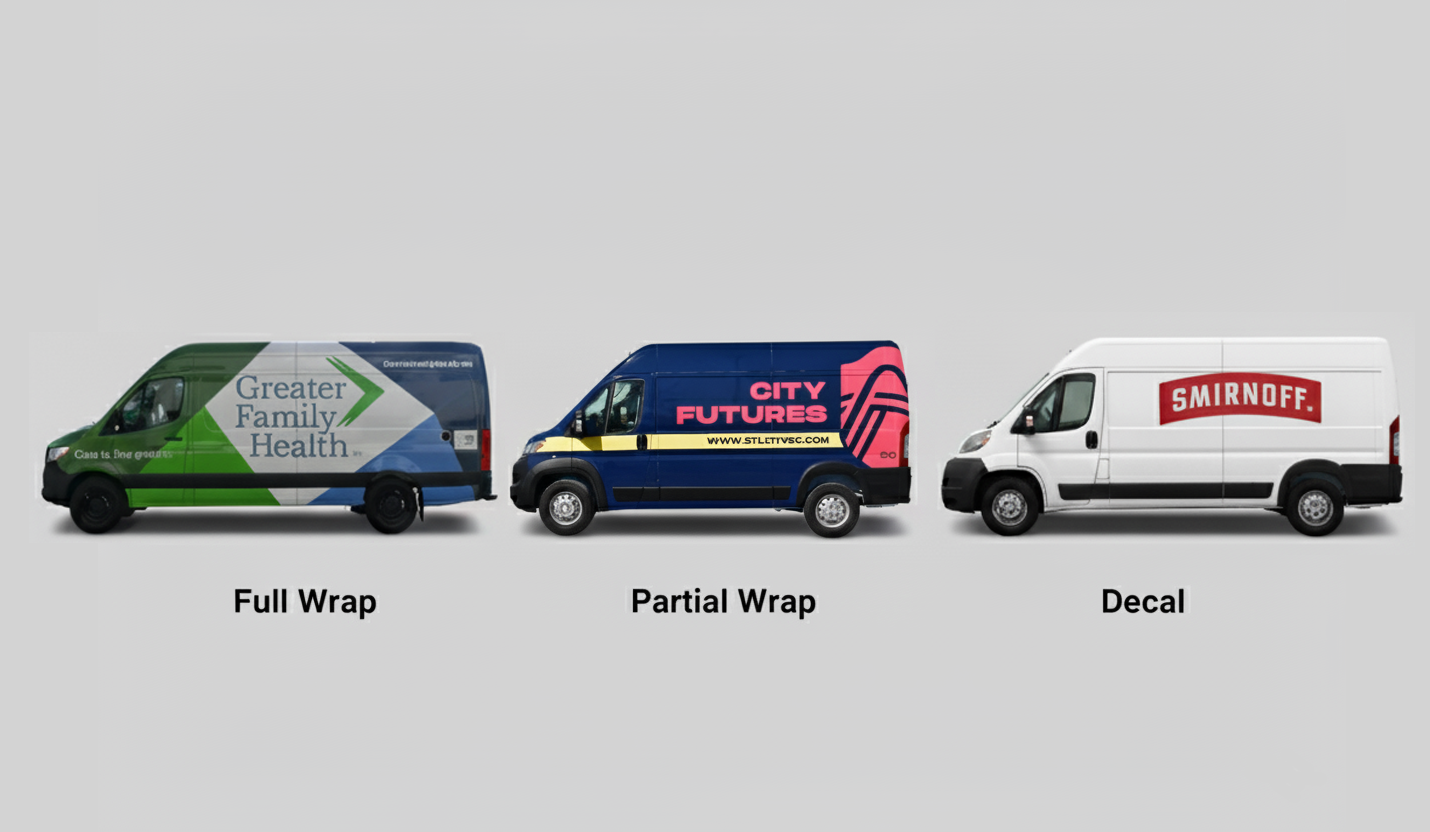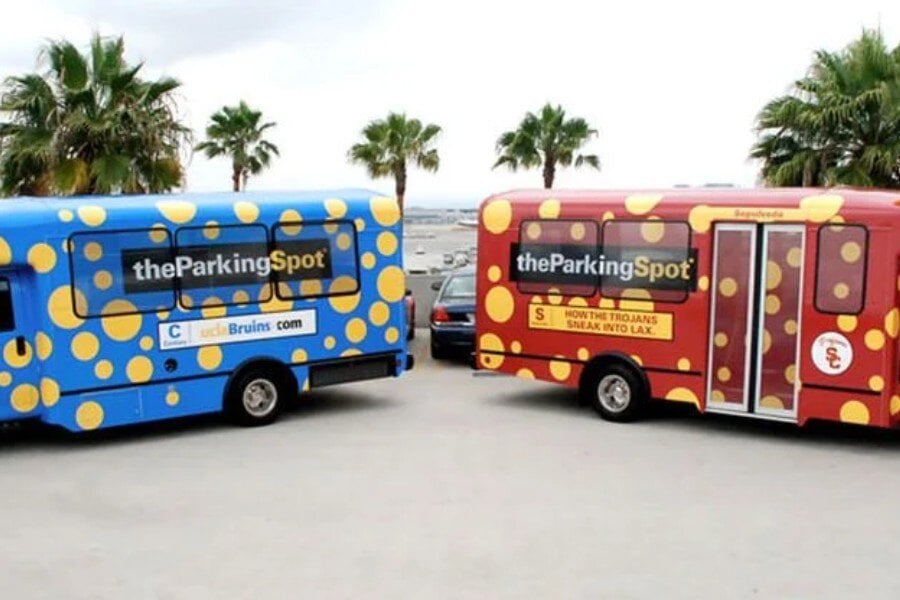Do Fleet Wraps Protect Vehicle Surfaces?
Maintaining a strong brand identity has never been as important in today’s fast-paced, dynamic business landscape. With fleet wraps, both small and...
11 min read
Craftsmen Industries Oct 20, 2025 7:10:23 AM

Fleet wraps are custom vinyl graphics applied to vehicles, turning everyday company cars, vans, or trucks into high-visibility advertising tools. Unlike traditional ads, wraps work 24/7 wherever your fleet travels, building brand awareness in local and regional markets. In fact, a single wrapped vehicle can generate 30,000 to 70,000 daily impressions, making it one of the most cost-effective forms of out-of-home advertising.
This guide will help you understand the cost of fleet wraps and their potential ROI, design strategies for maximum impact, and key considerations for installation and maintenance. Whether you manage a small business or a large fleet, you’ll discover practical best practices that ensure your investment delivers long-term visibility and measurable results.
Fleet wraps are large vinyl graphics applied directly to company vehicles, transforming them into moving billboards. Unlike paint, which permanently alters the car, wraps can be installed and removed without damaging the original surface. This makes them a flexible option for businesses that want to refresh branding or update promotions.
It’s important to differentiate between fleet wraps and fleet graphics. Fleet graphics often involve smaller elements such as logos, contact details, or partial decals. In contrast, a full wrap covers nearly every exterior surface of the vehicle, including windows with perforated film, offering a seamless, high-impact visual.
Partial wraps focus on specific areas, such as the sides, hood, or rear. While more budget-friendly, partial wraps can still make a strong impression when designed strategically.
Fleet wraps continue to gain popularity because they combine everyday mobility with constant brand exposure. Compared with traditional advertising, they deliver visibility at a fraction of the cost. Here are the main reasons businesses are turning to wraps:
By blending high visibility, consistent branding, and measurable ROI, fleet wraps stand out as a strategic choice for companies aiming to maximize every marketing dollar.
Fleet wraps come in several formats, each catering to different branding needs, budgets, and design goals. Understanding what each type offers helps businesses make informed decisions about visibility, impact, and cost.
A full wrap covers the entire vehicle, including the sides, hood, roof, bumpers, and sometimes the windows, creating a complete visual transformation. This option offers maximum marketing reach and protection for the original paint. It’s ideal for making bold statements and achieving consistent fleet branding.
A partial wrap covers specific areas of a vehicle, like the rear, hood, or sides. It’s more budget-friendly and quicker to install than a full wrap, but it provides a substantial visual impact when strategically designed.
Also known as cut graphics, these are small decals featuring logos, contact information, or minimal branding. They’re the most affordable form of vehicle branding and are easy to update or replace. Spot graphics are perfect when simple yet effective visibility is needed.
This category includes wraps with unique finishes such as chrome, matte, textured, or reflective vinyl. They’re often used for night-time visibility or to create eye-catching designs. Specialty vinyl (e.g., color-shift or carbon fiber textures) adds flair and stands out in unique lighting conditions.
Choosing between a vehicle wrap and a traditional paint job depends on factors such as cost, durability, flexibility, and overall branding strategy. Here’s an objective breakdown of key differences:
The cost of fleet wraps depends on the size of the vehicle, the extent of coverage, and the complexity of the design. While a sedan may only cost a few thousand dollars to wrap, a large truck or bus requires more vinyl and labor, resulting in a higher price point.

According to Kelley Blue Book, a full vehicle wrap typically costs between $2,000 and over $10,000, with small vans costing approximately $3,000 to $4,500 and pickup trucks costing around $3,200 to $5,000. Commercial wrap pricing guides indicate that a standard cargo van’s full wrap costs between $3,025 and $6,005, partial wraps cost between $2,125 and $3,675, and spot graphics or decals typically cost between $1,100 and $1,700.
According to independent industry data, full wraps on vans and pickup trucks generally range from $3,000 to $5,500. Larger commercial vehicles, such as box trucks or buses, typically cost anywhere from $3,300 to $7,115, while full trailer wraps average $8,500 to $10,000, depending on size and complexity. Sedans and SUVs are typically less expensive, with full coverage averaging around $3,000 to $4,000 per year.
The first factor influencing wrap cost is design complexity. A straightforward layout with a few logos will be more affordable than a highly customized, illustration-heavy wrap that requires hours of graphic design.
Wrap material quality also matters; premium vinyl from trusted manufacturers like 3M or Avery Dennison may cost more upfront, but it delivers a longer lifespan and better resistance to fading. Fleet size also impacts cost, as wrapping multiple vehicles at once often qualifies businesses for discounts on design and installation.
Businesses should also plan for additional expenses beyond the base installation. Removing an old wrap can incur significant labor costs, particularly if the vinyl has deteriorated or was applied incorrectly. Downtime is another hidden cost; when vehicles are being wrapped, they are temporarily off the road and not generating impressions.
Lastly, pre-wrap preparation may involve repairing dents, rust, or scratches to ensure the vinyl adheres properly and maintains a clean finish. Factoring in these costs upfront ensures a more accurate budget forecast.
The return on investment for fleet wraps is best measured through the cost-per-impression model, which evaluates advertising expense against the number of views generated. Vehicle wraps have one of the lowest advertising costs per thousand impressions (CPM), averaging just $0.48 to $0.77. By comparison, billboards average $3.56, transit ads $7.45, and newspapers $19.70. This makes wraps one of the most cost-efficient marketing investments available.
Fleet wraps offer daily visibility on a scale few other media can match. A single wrapped vehicle can generate between 30,000 and 70,000 impressions daily, depending on its location and traffic volume.
Research also shows that moving media has a high retention rate, with wrap advertising achieving a 97% recall rate, surpassing that of static ads. This means wraps not only deliver impressions but also make a lasting impact on potential customers.
Another strength of fleet wraps is that the investment is spread over several years. A professionally installed wrap is a one-time cost that continues to generate impressions throughout its lifespan.
Unlike billboards or digital ads that require ongoing payments, a wrap is a single purchase that keeps working for your brand every time the vehicle is on the road. This results in a lower cost per impression over time and improves long-term ROI.
Real-world examples demonstrate the significant impact that wraps can have. A plumbing company in North Carolina reported recouping its wrap investment in under six months after securing several new service contracts, directly attributed to the wrap's visibility.
In another case, a food delivery business noted a good increase in inbound calls within three months of branding its fleet. These cases highlight how wraps do more than create awareness; they can directly generate measurable revenue growth.
A well-designed fleet wrap is more than a moving billboard; it’s a marketing investment that can deliver thousands of impressions daily. But to make that investment pay off, the design must communicate clearly, be instantly recognizable, and remain consistent with your brand identity. Below are the best practices that leading companies use to maximize the impact of their fleet wraps.

Your fleet is often the first point of contact customers have with your business. That means your wrap should be an extension of your website, ads, and storefront. Use consistent brand colors, logo placement, and typography so your identity is instantly recognizable.
For example, FedEx maintains a consistent, simple purple-and-orange scheme across its trucks worldwide, which helps customers identify its vehicles even from a distance. Consistency across your fleet fosters familiarity and trust, which are crucial for brand recall.
Fleet wraps must be legible in traffic, where drivers only have a few seconds to process information. To achieve this:
Industry guidelines recommend a 3-inch letter height for every 50 feet of viewing distance. That means if your trucks are visible on highways, the text should be at least 12 inches high to remain readable at a distance of 200 feet.
Calls to action (CTAs) turn impressions into leads. A strong wrap always includes a phone number, website, QR code, or social media handle in a spot that’s easy to scan. Keep messaging short and action-oriented, such as “Call Today,” “Visit Us Online,” or “Scan for a Free Quote.”
While clarity is critical, creativity makes your fleet stand out in a crowded market. High-quality imagery, bold graphics, or storytelling visuals can create memorability. For example:
The key is balance: Creative elements should capture attention without overwhelming essential branding or CTAs.
A strong design can fall flat if the installation is poorly executed. Professional installation ensures the vinyl adheres properly, looks polished, and lasts longer. Businesses that cut corners here often pay more for repairs, replacements, or reputational damage from sloppy wraps. The following are the steps for the installation of fleet wraps:

Proper preparation is critical before any vinyl application. Vehicles must be:
Skipping this stage can reduce the wrap’s lifespan by years and lead to premature peeling.
Choosing between DIY and professional installation can be tempting if you’re trying to save costs. However, professionals bring expertise in handling large vinyl sheets, applying heat, and working around curves, rivets, and edges. This not only reduces mistakes but also ensures warranties remain valid.
By contrast, DIY installations often result in bubbles, wrinkles, and alignment issues that compromise the durability of the wrap. According to industry experts, poor installation techniques can reduce a vinyl wrap’s lifespan by 40–60%, emphasizing the importance of professional services for long-term durability.
Once installed, wraps should undergo a post-installation inspection. Professionals check for:
Final steps often include post-heating, which locks vinyl into shape and prevents early failure. Businesses should also ask for care instructions to maximize wrap longevity.
Fleet wraps are more than mobile billboards; they are investments in brand visibility that can deliver millions of impressions over their lifespan. However, neglecting simple care practices can shorten their life and diminish their visual impact. Here are some valuable tips:
Regular cleaning prevents pollutants, bird droppings, and road grime from becoming embedded in the vinyl. Hand washing is considered the gold standard because it’s gentle on the material. A soft sponge or microfiber cloth paired with a mild, non-abrasive detergent helps keep colors vibrant without scratching the film.
Pressure washing can be an option for fleets, but it comes with specific rules. 3M’s official cleaning guidelines specify keeping the nozzle at least 1 foot away, maintaining water temperatures below 180°F, and maintaining pressure under 2000 psi. Ignoring these can cause edges to lift or ink to fade prematurely. Setting up a routine wash calendar with strict schedules for fleets ensures no vehicle is neglected.
How and where vehicles are parked at the end of the day greatly influences wrap longevity. Constant exposure to UV rays, snow, or acid rain accelerates the cracking and fading of colors. Fleets should be stored indoors or under a covered parking area.
For companies that lack indoor space, simple adjustments, such as rotating parked vehicles to reduce sun exposure on one side, can make a difference. Investing in UV-protective laminates or high-quality films also pays off by resisting heat and environmental stress.
Preventive inspections save both time and money. Small issues, such as peeling seams or minor scratches, can often be repaired without replacing large panels, provided they are spotted early. Fleet managers should:
By treating wrap inspections like any other preventive maintenance, businesses can extend the life of their wraps and avoid unexpected re-wrap costs.
When properly cared for, fleet wraps generally last 3 to 7 years, depending on the vinyl quality, climate, and care practices. Premium films from brands like 3M and Avery Dennison come with warranties of up to 7 years; however, real-world performance depends heavily on environmental exposure and proper upkeep.
Several factors determine actual lifespan:
It’s also worth noting that wraps do more than advertise. They shield the original paint from scratches, UV rays, and minor abrasions, helping preserve resale value when vehicles are rotated out of the fleet.
While fleet wraps offer impressive branding and cost advantages, they also come with specific challenges that businesses should consider before investing. Awareness of these limitations helps companies plan for ongoing care, compliance, and budgeting:
One of the most common issues with wraps is color fading over time, particularly in vehicles that spend most of their time outdoors. Prolonged UV exposure can cause colors to lose vibrancy, particularly on darker shades. Manufacturers like 3M recommend UV-resistant overlaminates and parking vehicles in shaded or indoor spaces to slow deterioration.
Fleet wraps are susceptible to scratches, tears, or punctures from accidents, harsh weather, or improper washing. While small damaged areas can sometimes be patched, repairs may require reprinting and reinstalling larger panels for a seamless look. This makes repair costs unpredictable compared to paint, where minor scratches can often be touched up more easily.
Some businesses consider reflective or specialty vinyls for night visibility. However, specific states regulate reflective materials on commercial vehicles to prevent them from distracting other drivers. Before installation, companies should verify local and federal guidelines to ensure compliance with relevant regulations.
Even under proper care, wraps generally last 3–7 years, depending on material and exposure. Once past their warranty period, peeling, cracking, or adhesive residue may occur. This requires complete replacement or professional removal, which adds to long-term operating costs.
The cost typically ranges between $2,500 and $5,000 per vehicle, depending on size, design complexity, and materials used.
Most fleet wraps last 3 to 7 years, but this depends on proper maintenance, climate, and the quality of the vinyl film.
No, professionally installed wraps generally protect the paint underneath. If removed correctly, they can even help preserve resale value.
Yes, wraps are designed for removability. Businesses often update or rewrap vehicles more quickly and affordably than they do by repainting.
Fleet wraps provide one of the lowest cost-per-thousand impressions (CPM) in advertising. According to the Outdoor Advertising Association of America (OAAA), vehicle ads can generate 30,000–70,000 daily impressions at a fraction of the cost of billboards, TV, or digital ads.
Fleet wraps offer a powerful balance of affordability, visibility, and flexibility. With costs ranging from a few thousand dollars per vehicle and an average lifespan of 3–7 years, they deliver a far lower cost-per-impression than traditional advertising channels. Their ability to protect car paint, allow for easy updates, and generate tens of thousands of impressions daily makes them one of the most cost-effective branding tools.
Businesses can maximize the impact and longevity of their wraps by following best design, installation, and maintenance practices. The result is stronger brand recognition, measurable ROI, and vehicles that double as mobile billboards working around the clock.
At Craftsmen Industries, Inc., we specialize in creating high-quality, durable, and visually striking wraps that help businesses stand out on the road. Whether you need Fleet Wrap Services or Fleet Graphics Services, our team is here to bring your brand to life.

Maintaining a strong brand identity has never been as important in today’s fast-paced, dynamic business landscape. With fleet wraps, both small and...

Fleet graphics are professionally designed vinyl wraps or decals that transform company vehicles into mobile advertisements, enhancing brand...

In today’s fast-paced and competitive market, grabbing attention is more important than ever. While online ads may disappear after a click, fleet...